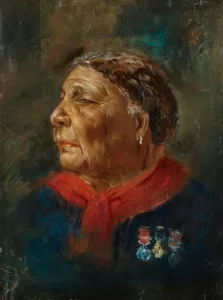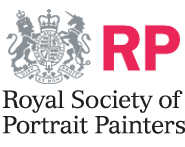
Albert Charles Challen, ‘Mary Seacole’
ESSAY:
Eminently Contemporary
Since the 1856 founding of the National Portrait Gallery, its mission has been to “maintain a collection of portraits of the most eminent persons in British history.” But what is, or should be, the measure of eminence? For Philip Stanhope, who appealed to the House of Lords in March 1856 for a “gallery of original portraits,” the parameters were more or less clear. Such a site, he submitted, should feature prominent men already recognised “as warriors or as statesmen, or in arts, in literature or in science.”
The Earl Stanhope had already floated the proposal twice before. This time he came equipped with further backing, reading aloud letters from Thomas Carlyle which declared the portrait to be “superior in real instruction to half-a-dozen written biographies.” Carlyle’s own 1840 lecture series, “On Heroism, Hero-Worship and the Heroic in Society,” had already expounded a theory of history based on the admirable deeds and inimitable character of Great Men. For Carlyle—a biographer and historian himself—portraiture offered a means of personal edification as well as national enlightenment.
Recently reopened after a three-year renovation, the National Portrait Gallery continues to grapple with the legacy of its early founders and trustees. Today, the museum aspires to foreground a more inclusive understanding of British identity. Its redesign is meant to showcase a vaster array of those who have “made an impact on British history.” Yet “eminence” continues to be the yardstick for the display and acquisition of its collection. In retaining that measure of distinction, while also seeking to elevate history’s more overlooked figures, the revamped NPG also rekindles a tension at the heart of modern portraiture—a tension between the singular and the collective, and between individual renown and generalizable type. Can the very logic of a national portrait gallery elude an idea of history as an ineluctable march of progress and glory, led by those proclaimed to be “great”?
Both a history of British portraiture and a history of Britain through portraiture, the NPG has tended to privilege the celebrity of the sitter over the aesthetic achievement of the artist. Even before it opened to the public in 1859, competing understandings of its national—and ideological—aims had already sparked debate. How important was the portrait’s “authenticity,” that is, historical likeness? (It was decided that portraits should date from the same era as their subjects: the founders scoffed at those “imaginary” portraits, painted many years after their sitters’ deaths, that flanked contemporary Scottish and French galleries.) But within a post-Byronic culture of celebrity—epitomised by the popular literary “portrait galleries” of Fraser’s Magazine—how would the Gallery avoid merely rewarding celebrity for celebrity’s sake? (A “10-year rule” forbidding the acquisition of any portrait until a decade after its sitter’s death sought to evade this tautological problem of eminence: the rule remained in place until 1969). The founders ultimately settled on a Horatian logic of education, instruction, as well as visual pleasure for its projected audience. To what extent, then, should moral virtue serve as a criterion for inclusion? (Eventually it was agreed that certain “faults and errors,” when balanced against a potential subject’s “significant contribution” to British history, would not absolutely doom their chances.)
The redesigned NPG’s evolving understanding of “eminence” has genuinely transformed the look of its halls. Forty-eight percent of post-1900 galleries now feature women, compared to 35 percent in 2020. An 1869 portrait of Mary Seacole, rediscovered only in 2002, is now given pride of place on the second floor. Around the corner, a “wall of fame” presents dozens of cartes de visite which, thanks to the expansion of photography in the 1850s, circulated on a mass scale and helped to democratise access to the image. An “Everyday Portraits” section de-monumentalises European portraiture by displaying medallions, sketches, miniatures, and faces of revolutionary and anticolonial figures spray-painted onto industrially produced T-shirts.
The “History Makers” wall that occupies the ground floor, the first set of portraits that most visitors will see, swerves even further away from portraiture’s history as an elite form of aesthetic production, even as it also recalls the crowded, maximalist setup of eighteenth-century exhibitions. Subjects range from King Charles to the writer Jeanette Winterson, from Vogue editor Anna Wintour to filmmaker Steve McQueen. (They are a reminder, if we needed one, that “eminence” has no necessary politics.) Meanwhile, a tapestry along the opposite wall commemorates the “key workers, the unsung heroes of the COVID-19 pandemic.”
In the mid-nineteenth century, Stanhope and Carlyle were serenely confident about promoting a Victorian narrative of national progress and imperial grandeur. For the pre-1900 galleries, the NPG has now opted for recuperation and contextualisation in turn in order to tackle the internal contradictions of a nation and empire that grew rich off the oppression of its own working classes, as well as the enslavement and exploitation of colonial subjects abroad. Slaveowner Sir John Gladstone’s distinguished portrait (c. 1830), for instance, is the museum’s main existing record of the Demerara Uprising of 1823, in which 10,000 people in current-day Guyana rose up against their oppressors. It is now paired with a 2021 pen-and-ink drawing by Errol Ross Brewster of one of the uprising’s leaders, Jack, son of Quamina.
Amid its extensive rehang and thoughtful redesign, however, the National Portrait Gallery has largely retained its celebratory mode. In that sense the Gallery has not gone nearly as far in interrogating the very category of “eminence” as Lytton Strachey did over a century ago. Strachey’s Eminent Victorians (1918), composed during a war that was testing British elites’ capacity for self-mythologising, offered four lively, avowedly partial (and sometimes simply factually incorrect) portraits of Cardinal Manning, Florence Nightingale, Dr Thomas Arnold, and General Gordon. These “haphazard visions,” as Strachey described them, abrogated any attempt at cohesion, much less an alternative national narrative. Rather, by means of gauzy irony and proto-modernist juxtaposition, Strachey would expose certain “fragments of the truth.”
Traditionally, portraits were ranked beneath history painting in the hierarchy of genres precisely because they portrayed their subjects as individuals, not as instances of a general rule. Over the course of the nineteenth century, the priority of Joshua Reynolds’s “general effect” over, say, William Blake’s “minute particulars” began to cede ground, as portraiture came to align with the legitimacy and dignity of the individual subject. Personhood, originality, depth of character: these aspects of the post-Romantic self are some of the most cherished affordances of the modern portrait.
The new NPG wants to emphasise “the story of those who may not have had their portrait made,” in the words of director Nicholas Cullinan. Yet as its own collections reveal, Britain’s official culture long ascribed personhood itself—with its incumbent property rights, voting privileges, not to mention autonomy and basic dignity—only to some.
In Karl Marx’s Eighteenth Brumaire of Louis Bonaparte—the source of his famous statement that history repeats itself, first as tragedy, then farce—he reflected on the possibilities, and failures, of revolutionaries to resist and overcome these realities. Along the way, Marx put forward a historical materialist’s understanding of the relation between the individual and the masses: “Men make their own history, but they do not make it just as they please.” Ninety years later, CLR James echoed Marx in his own account of the Haitian Revolution, a biographical portrait of the revolutionary leader Toussaint Louverture in the context of the modern world’s first successful slave revolt: “Great men make history, but only such history as it is possible for them to make.” In both cases, individual eminence is only one piece of a dialectic between circumstance, leadership, and the resistance of those more often unremembered.
Unremembered by whom, we might ask? The new NPG includes several more daring attempts to reconsider the definition of portraiture. A plaque hanging beneath a famous photographic portrait by Julia Margaret Cameron of the Jamaican Governor Edward Eyre asks, “But where are the Jamaican protesters?” Below, an interactive screen lends visitors the chance to experience a series of “portraits in sound.” Songs and lyrics by Jamaican and other reggae artists, from Culture’s “Innocent Blood” to Steel Pulse’s “Born Fe Rebel,” commemorate Paul Bogle and George William Gordon, leaders of the Morant Bay rebellion, as Eyre—who brutally suppressed the rebellion, with Carlyle’s support—looks broodingly on.
To paint someone’s portrait can lead to a radical reversal of hierarchies or it can merely entrench them. At their best, the redesigned galleries of the NPG ask viewers to consider portraiture not as a static form but as an evolving, ongoing practice, one susceptible to change—and open to contestation. Portraits, in this sense, are not only icons of the great: they also take part in material histories of social struggle that extend beyond the canvas frame.
To stay in touch and hear the latest news please subscribe to our newsletter

